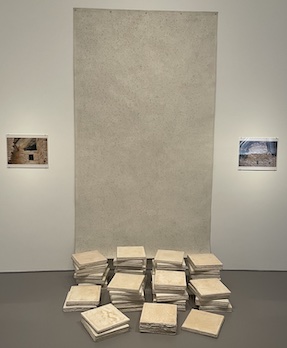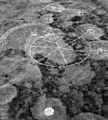Michelle Stuart facts for kids
Quick facts for kids
Michelle Stuart
|
|
|---|---|
| Born | 1933 (age 91–92) |
| Nationality | American |
| Education | Chouinard Art Institute |
| Awards | Guggenheim Fellowship (1975), NEA Grants (1975, 1977, 1980, 1989) |
Michelle Stuart (born in 1933) is an American artist who creates amazing art using many different forms. She is known for her sculptures, paintings, and special "environmental art" that connects with nature. Michelle lives and works in New York City.
Early Life
Michelle Stuart grew up in Los Angeles, California. After studying at the Chouinard Art Institute (which is now called the California Institute of the Arts), she worked as a draftsperson. This means she drew detailed plans and maps. Around 1951, she worked in Mexico as an assistant to the famous artist Diego Rivera.
In 1953, she married José Bartoli, an artist from Catalonia. Michelle lived in Paris for three years before moving to New York City in 1957. She has lived there ever since.
Her Artworks

When Michelle Stuart first started her art career, she was inspired by new photos of the Moon's surface. She saw how her early drawings, which used a rubbing technique, looked like these lunar landscapes. These bright drawings, often in one main color, brought a new type of art called land art into art galleries.
During this time, Michelle also created "drawings in the landscape." One famous example is Niagara Gorge Path Relocated (1975). For this artwork, she placed a very long scroll of paper, about 460 feet, down a large bank of the Niagara River Gorge.
In the 1980s, Michelle Stuart changed her artistic focus. She started making paintings with a grid pattern. She would embed things like beeswax, seashells, flowers, leaves, and sand into the surface, using a technique called encaustic (which uses melted wax). She also created complex art installations that included light and sound.
Her series called Extinct (1993) was inspired by an old album of leaves from the Victorian era. For one piece in this series, she used the grid pattern again, placing different dried plants in each section. She also created Seed Calendar drawings, which used a grid to show how a seed grows and changes over time.
Michelle Stuart also loves books and writing. She has shown this love through her art in many ways. In the early 1970s, she began her "Rock Book" series. These artworks look like old, worn journals and are made from natural materials found at specific places. They are like unique travel logs. For example, in Homage to the Owl from Four Corners (1985), she combined earth, owl feathers, string, and beeswax to create a book.
She has also published her own artist's books, including The Fall (1976), which is a long story-poem about keeping historical records, and Butterflies and Moths (2006).
Today, Michelle Stuart continues to live and work in New York City and Amagansett, Long Island.
Exhibitions
Michelle Stuart's art has been shown in Europe, Asia, and the United States for over thirty years. Her works have been displayed in many famous places, including:
- Museum of Modern Art, New York
- Museum of Contemporary Art, Los Angeles
- Hirshhorn Museum and Sculpture Garden, Washington, D.C.
- San Francisco Museum of Modern Art
- The National Museum of Modern Art, Kyoto, Japan
She has also had solo exhibitions (shows featuring only her art) at places like:
- Walker Art Center, Minneapolis
- Massachusetts Institute of Technology, Cambridge, MA
- Institute of Contemporary Arts, London
- Williams College Museum of Art, Williamstown, MA
In 2013, a special exhibition that focused on her drawings traveled to several museums, including the Santa Barbara Museum of Art and the Parrish Art Museum.
In 2008, Michelle Stuart was part of a group show called "Decoys, Complexes and Triggers: Feminism and Land Art in the 1970s" at the SculptureCenter in New York. Her art has also been featured in major international art events like Documenta VI in Germany and the American Biennial Pavilions in Seoul, Korea, and Cairo, Egypt.
Michelle Stuart has also created art for specific locations. Some of her special projects include:
- Paradisi: A Garden Mural, a large artwork in the main lobby of the Brooklyn Museum.
- Starmarker and Star Chart: Constellations, outdoor sculptures in the Wanas Sculpture Garden in Sweden.
- Garden of Four Seasons, a bronze and marble sculpture in Tochige, Japan.
- Tabula, a thirty-four-part marble artwork at the New Stuyvesant High School in Battery Park, New York City. She even won an award for its design!
Notable Works in Public Collections
Many important museums and art foundations around the world own artworks by Michelle Stuart. This means her art is preserved and can be seen by the public for many years to come. Some of her notable works in public collections include:
- Seeded Site (1969-1970), Tate, London
- Zena (Vertical), NY (1972), Art Institute of Chicago
- #7 Echo (1973), Menil Collection, Houston
- #38 Moray Hill (1973), Menil Collection, Houston
- #1 Woodstock, NY (1973), Tate, London
- #4 Woodstock (1973), Allen Memorial Art Museum, Oberlin, Ohio
- #28 Moray Hill (1974), Whitney Museum, New York
- Turtle Pond (1974), Museum of Contemporary Art, Chicago
- Turtle Pond Site Drawing #36 (1974), Museum of Contemporary Art, Chicago
- Notes: Sayreville, N.J. (1975), National Gallery of Australia, Canberra
- Spiral Notebook (1975), San Francisco Museum of Modern Art
- Suite Tsikomo (1975), National Gallery of Art, Washington, D.C.; and Philadelphia Museum of Art
- Breezy Point, New York (1976), National Gallery of Australia, Canberra
- Fossil Series: Barnegat Bay I (1976), Allen Memorial Art Museum, Oberlin, Ohio
- Sayreville, N.J., Claypits, No. 49 (1976), Detroit Institute of Arts
- Sayreville Quarry II (1976), Detroit Institute of Arts
- Sayreville Strata Quartet (1976), Dia Art Foundation, Beacon, New York
- Hermosa Strata, Colorado (1977), Whitney Museum, New York
- Ledger Series: Stone Barrow, South Group, Pecos, New Mexico (1977), Art Institute of Chicago
- Mesa Verde, Colorado (1977), Art Institute of Chicago
- Passages: Mesa Verde (1977-1979), Hirshhorn Museum and Sculpture Garden, Smithsonian Institution, Washington, D.C.
- The Dalles Book (for chief Joseph) (1979), Moderna Museet, Stockholm
- Zacaba (1979), San Francisco Museum of Modern Art
- El Florido Tunil (Stones Precious of El Florido) (1980), Philadelphia Museum of Art
- Islas Encantadas Series: Materia Prima I (1981), Museum of Modern Art, New York
- Nazca Lines Star Chart and Nazca Lines Southern Hemisphere Constellation Chart Correlation (1981-1982), Museum of Modern Art, New York
- Makan Series: Bin Yusuf (1982), Buffalo AKG Art Museum, Buffalo, New York
- The Navigator (1984), Brooklyn Museum, New York
- Cape Sebastian (1988), Museum of Contemporary Art, Los Angeles
- Town Creek Mound (1987-1989), San Francisco Museum of Modern Art
- Roman Seed Calendar V (1995), Museum of Contemporary Art, Los Angeles
- Roman Berry (1996-1997), Art Institute of Chicago
- Ring of Fire (2008-2010), Musée National d'Art Moderne, Centre Pompidou, Paris
- These Fragments Against Time (2018), San Francisco Museum of Modern Art
Awards
Michelle Stuart has received many awards for her art, including:
- The CAPS Grant from New York State (1974)
- A Guggenheim Fellowship (1975)
- National Endowment for the Arts Grants for Individual Artists (1974-1977; 1980)
- The New York City Art Commission Award for excellence in design (1990)
- The Anonymous Was A Woman award (2017)
Gallery
-
Niagara River Gorge Path Relocated / Art Park, Lewiston, NY,1975. This artwork is 420 feet long and uses rock indentations and red shale from the site on muslin-mounted rag paper.
-
Solstice Cairns / Columbia River Gorge,1979. This large artwork is about 1,000 by 800 feet and uses approximately 3,200 boulders.




